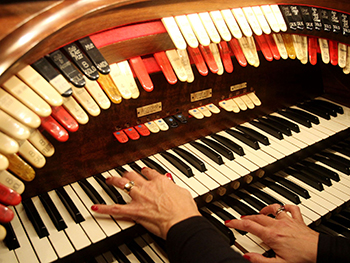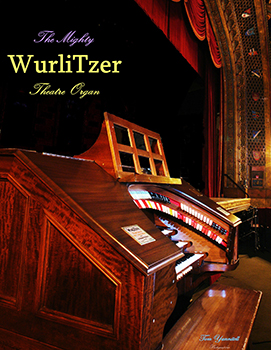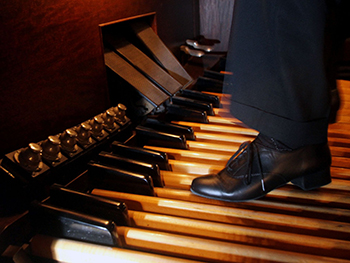The Mighty Wurlitzer Organ
 The Marion Palace Theatre considers itself fortunate to be among the list of historic theatres that are still home to a working theatre pipe organ; today a Wurlitzer but originally a Page.
The Marion Palace Theatre considers itself fortunate to be among the list of historic theatres that are still home to a working theatre pipe organ; today a Wurlitzer but originally a Page.
The Palace Page organ held of role of significant importance in 1928. The construction of the Palace included necessary wiring for talking movie pictures. It would, however, be some time before the Theatre received and installed that equipment. This gave the “voice” of the Palace Page a role of honor.
While patrons revered the stars of stage and screen, the organ and those seated on the bench were equally held in high esteem. The instrument and its player were vital to the success of the Theatre’s entertainment line-up.
Theatre management used the organ not only during intermission, but it gave expression to silent films through a myriad of sounds, thus conveying the very ambiance a movie’s director intended. The organist would also play background music for performing Vaudevillians, and then offer a musical signal upon completion of the entertainment as a cue for guests to exit the theatre.
The Marion Palace Theatre was first home to an ornate, three-manual Page Rainbow Gold. The instrument was built specifically for the Marion location. Unique in its finish, the Page shone beams of light into the auditorium as the spotlight reflected off its surface.
 First played by Banks Kennedy, after the Theatre’s opening the local paper reported a fascination with not only the instrument’s musicality but its beauty and “artistic effect.”
First played by Banks Kennedy, after the Theatre’s opening the local paper reported a fascination with not only the instrument’s musicality but its beauty and “artistic effect.”
While the timing of the sale is disputed, it is agreed upon that theatre management sold the organ to help pay down the struggling Theatre’s debt. Valuing the history of the theatre organ’s role, new management later replaced the Page with The Mighty Wurlitzer Theatre Pipe Organ.
The Wurlitzer is a 3 manual, 10 rank Style 235 Special “Hope-Jones Unit Orchestra.” Opus 893. The instrument left the Wurlitzer factory on Aug. 30, 1924. It was originally installed in the Mars Theatre, Lafayette, Indiana, which is now the Long Center. The organ was later installed in the Al Mason residence in Lavonia, Michigan. Mr. Mason was, for some time, the national president of the American Theatre Organ Society.
The late Tom Yannitell procured the organ and, with the help of a crew of volunteers, installed it at the Marion Palace Theatre. The installation was completed in time for the 50th anniversary and reopening of the Palace in 1978.
The Wurlitzer sits atop a giant gear that elegantly lifts the mighty machine from the orchestra pit into full view of an awe struck audience.
The magnificent instrument is capable of reproducing the sounds of an entire orchestra. Also equipped with silent film sound effects and other “bells and whistles,” the Wurlitzer mimics a train whistle, Chinese gong, siren, sleigh bells and even chirping birds.
 For theatre organ enthusiasts we know that modern electronics upgrades to the organ include the 1989 installation of a Z-tronics relay, taking the place of the original electro-pneumatic relay. Additionally, a Trousdale combination action was installed in 1991-92. Utilizing modern digital electronics, it replaced the original, console-filling electro-pneumatic action. At the same time, more stop tabs were added, bringing the total number of tabs to around 120. Other upgrades were the 2003 installation of a Z-tronics MIDI system and an almost complete restoration of the organ from 2001-2003.
For theatre organ enthusiasts we know that modern electronics upgrades to the organ include the 1989 installation of a Z-tronics relay, taking the place of the original electro-pneumatic relay. Additionally, a Trousdale combination action was installed in 1991-92. Utilizing modern digital electronics, it replaced the original, console-filling electro-pneumatic action. At the same time, more stop tabs were added, bringing the total number of tabs to around 120. Other upgrades were the 2003 installation of a Z-tronics MIDI system and an almost complete restoration of the organ from 2001-2003.
The late Tom Yannitell led the restoration effort, assisted by the late Joe Weygandt, Stan Krider, and Dave Kohler. In recent years Dave Kohler, assisted by Jack Shaffer, has provided repair and maintenance for the Mighty Wurlitzer organ.
In July 2016, the American Theatre Organ Society included the Marion Palace Theatre in their tour. Donnie Rankin, the 2007 winner of the Young Theatre Organists Competition, performed on The Mighty Wurlitzer for an appreciative audience.
Resources include A Theatre History of Marion Ohio: John Eberson’s Palace & Beyond authored by Scott L. Hoffman. Additional information provided by Dave Kohler.
